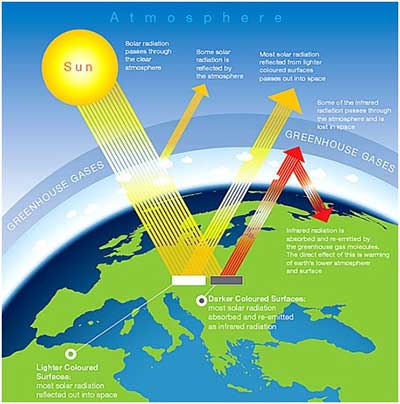ALBEDO Effect
- The phenomenon of a body or a surface reflecting a fraction of light is called as ‘Albedo.’ It is used to refer the portion of solar energy reflected from the surface of the Earth back into space. It is a reflection coefficient and has a value of less than one.
- Albedo is higher in Snow or Ice.
- There are two types of Albedo – terrestrial albedo and astronomical albedo.
- The normal albedo is called normal reflectance (a measure of a surface’s relative brightness when illuminated and observed vertically.)
Terrestrial Albedo
- The measurement of Earth’s albedo is known as Terrestrial Albedo.
- The Terrestrial Albedo of Earth around 0.31 which is about two-thirds of the solar radiation reaching the Earth.
- This figure (0.31) is dependent on many factors like an ocean, forest, clouds, deserts etc.
Astronomical Albedo
- Astronomical albedo is the measure of the reflectivity of planets (excluding Earth), asteroids and other celestial bodies the albedo is an indicator of the surface and atmospheric characteristics of a celestial body.
- It is important in the study of astronomy.
- The difference in the average albedo of Earth has an important influence on the temperature of the Earth.
- If the average albedo is lower than the previous year’s albedo, it specifies that the amount of radiation absorbed is higher
- This results in the rise in the temperature of the Earth.
- Earth’s albedo is constantly measured using satellites to monitor global warming.
BIOLOGICAL OXYGEN DEMAND
- Animal respiration in the water and different chemical reactions consume oxygen in water. The amount of oxygen consumed by microorganisms to eliminate waste in water is known as the Biological Oxygen Demand (BOD).
- Scientifically defining, BOD, also called biological oxygen demand, is the amount of dissolved oxygen needed (i.e., demanded) by aerobic biological organisms to break down organic material present in a given water sample at certain temperature over a specific time period.
- Wastewater from sewer treatment plants, stormwater runoff and failing septic systems often contain much waste from microorganisms that must be broken down, and it takes a lot of oxygen for microbes to do it. This is a form of pollution that should be monitored to avoid doing damage to our environment.
CIRCLE OF ILLUMINATION
- The imaginary line on the Earth's surface that separates light from the darkness and day from the night is known as the circle of illumination.
- Earth’s axis refers to an imaginary line going through the centre of the earth from top to bottom.
- The circle of illumination cuts all latitudes into half on the spring and autumnal equinoxes.
- The circle of illumination bisects the equator while the circle of illumination separates light from darkness and day from night, the axis is a line along which the earth rotates.
- It is the division between day and night on earth.
- It always cuts through the equator at 90° and passes through the poles.
- It doesn't coincides with the Earth's axis due the 23.5° tilt.
CARBON TAX
- A carbon tax directly sets a price on carbon by defining a tax rate on greenhouse gas emissions or – more commonly – on the carbon content of fossil fuels.
- It is different from an Emission trading system (ETS) in that the emission reduction outcome of a carbon tax is not pre-defined but the carbon price is.
- A carbon tax is paid by businesses and industries that produce carbon dioxide through their operations. The tax is designed to reduce the output of greenhouse gases and carbon dioxide, a colorless and odorless incombustible gas, into the atmosphere. The tax is imposed with the goal of environmental protection
- A carbon tax is a fee imposed on businesses and individuals that works as a sort of "pollution tax."
- The tax is a fee imposed on companies that burn carbon-based fuels, including coal, oil, gasoline, and natural gas.
- The burning of these fuels produces greenhouse gases, such as carbon dioxide and methane, which heat up the atmosphere and cause global warming.
- A carbon tax is seen as reducing emissions by making it more expensive to use carbon-based fuels, therefore giving companies a reason to become more energy-efficient, so as to save money.
- A carbon tax would also increase the costs of gasoline and electricity, therefore giving consumers a reason to switch to clean energy.
CONDENSATION NUCLEI
- Condensation nuclei, also called as Cloud Condensation Nuclei (CCN), are tiny particles in the air on which water vapor condenses and they are the key to making clouds, fog, haze, rain, and other forms of precipitation.
- Condensation nuclei come in many forms. They can form from dust, soot from fires and vehicle exhaust, sea salts from waves crashing onto shore, volcanic eruptions, or any other way small particles enter the atmosphere.
- These particles are very small, average condensation nuclei is only about 1/100th the size of a cloud droplet.
- Because nuclei are made from different materials, they also differ in terms of their ability to form clouds (or fog).
Sources
- The Old NCERTs class 6-12th
- NASA.gov
- World Bank website
- Nature.com







